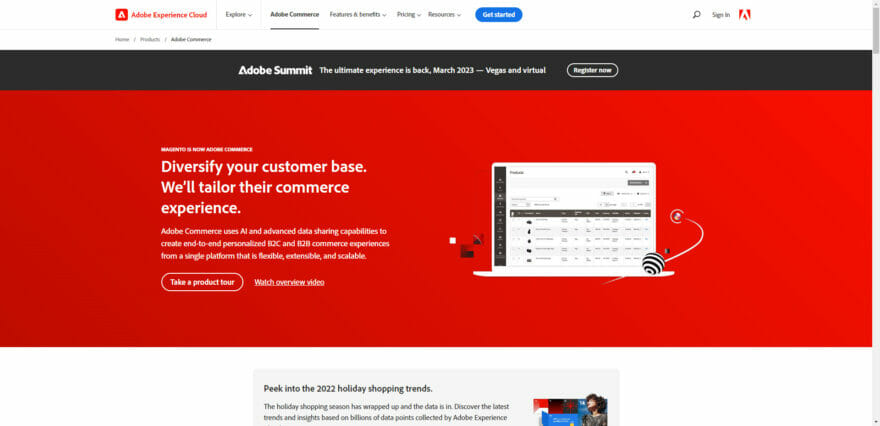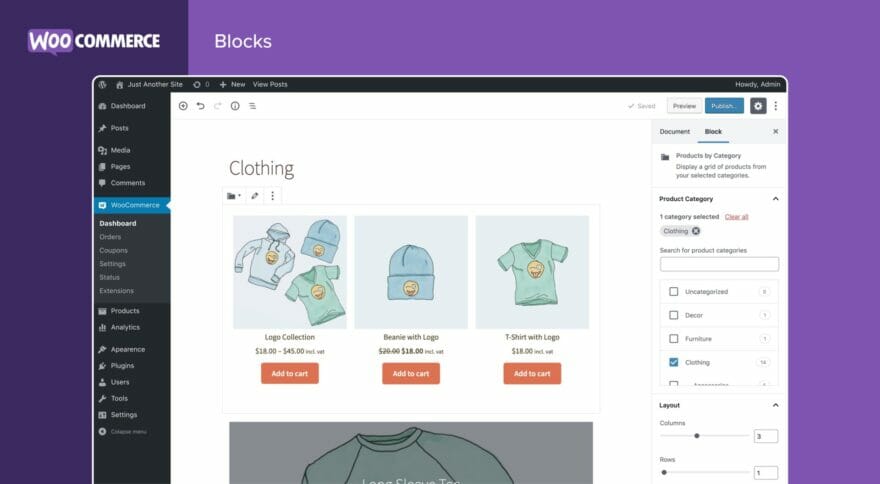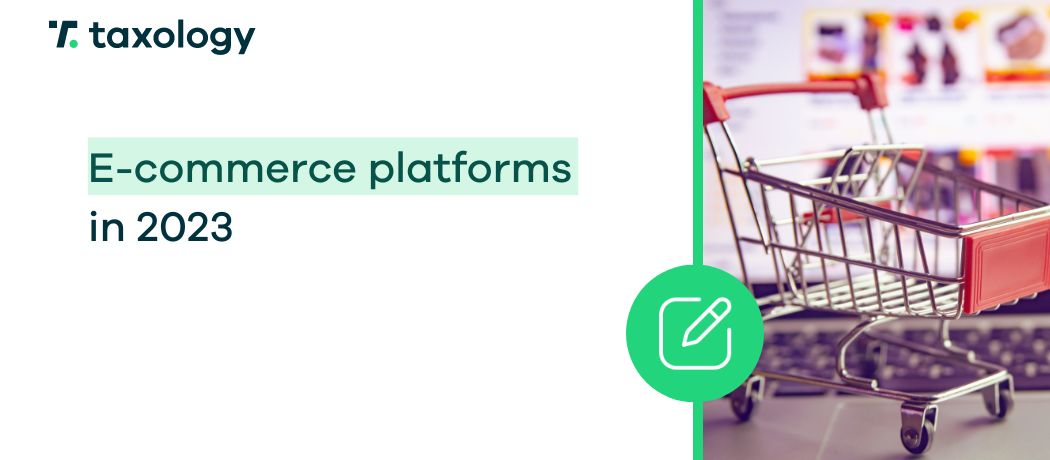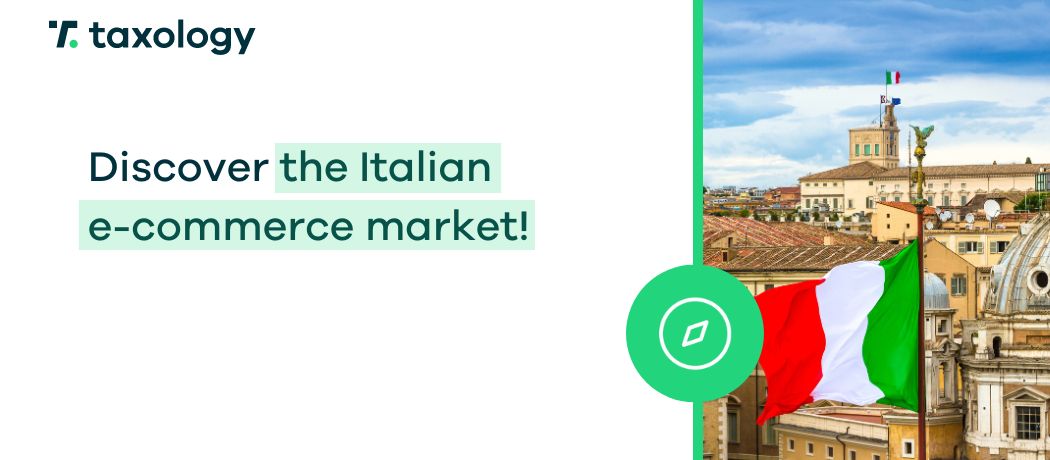France is one of the largest and wealthiest countries in Europe, making it an extremely attractive market for expansion for many entrepreneurs in the e-commerce sector. However, like any other […]
Read in: 5 minE-commerce platforms in 2023
- Last update: 23.02.2024
- Published: 03.01.2023
- Read in: 11 min
Choosing the right e-commerce platform for an online shop seems to become increasingly more challenging with each passing year. Competing solutions are racing to outdo each other on many levels, starting from user-friendliness and optimisation to lightning-fast integrations with many external tools. In the following article, we will investigate some of the most popular e-commerce platforms and try to answer the question of how to choose the appropriate one for us.
What is an e-commerce platform?
An e-commerce platform is a ready-made solution that enables you to create an online shop quickly and efficiently. The majority provide a full set of tools that enable entrepreneurs to start selling without having to invest in a team of developers.
What are the differences between e-commerce platforms?

Over the past decade, turnkey sales platforms have developed at a rapid pace. Moreover, every year new systems are developed providing a different set of advantages and developing their functionalities according to the needs of specific industries and types of companies. Currently, there are hundreds of such platforms available on the market and a number of important factors should be taken into account when choosing the most suitable one. Here are some examples:
- The available customisation options – depending on the type, architecture or extension availability, an online shop platform can offer retailers different options when it comes to implementing changes, adding integrations and modules.
- Cost of personalisation – this aspect mainly depends on how complex the process of implementing changes to the platform is. Some systems allow simplified changes even for people without advanced technical knowledge, while others require programmers’ assistance. As for the latter, the cost of personalisation will be significantly higher.
- Platform type – the two main types of e-commerce platforms are SaaS (Software as a Service) and open source. Open source platforms provide full access to the website’s source code and unlimited possibilities to modify it according to your own needs. SaaS platforms operate through a subscription model and offer ready-made solution bundles that are completely sufficient for driving sales. As a general rule, there are limited customisation possibilities when using SaaS platforms, nevertheless competitive solutions are outdoing each other to provide more and more attractive, comprehensive platforms for this model every year.
- Możliwości optymalizacji pod SEO – niektóre platformy zapewniają znacznie lepsze warunki do pozycjonowania w Google. Among other things, this can be facilitated by a Google-friendly site layout or the ability to easily add content in many places and by creating a blog. If the search engine is to ultimately be the key source of traffic, this aspect is worth paying particular attention to.
- Integration accessibility and implementation – the possibility of easy integrations with external systems is an extremely important asset of the platform In the absence of off-the-shelf solutions, such operations can be both time-consuming and costly. That is why, in any case, when choosing an e-commerce platform, it is necessary to consider all the systems we will need to integrate with it and the complexity of that integration. It is worth keeping an eye out for the possibility of quick integrations with accounting programmes such as Comarch Optima. For e-commerce businesses operating across multiple countries, it is recommended to seek professional support for accounting processes also for cost optimisation.
- International and omnichannel sales opportunities – not every sales platform provides the right tools to sell across multiple markets and channels, which is becoming a standard in the industry. If we plan on boosting sales using such methods, it is worth paying attention to whether the given e-commerce system will give us the means to do so.
Tax matters are particularly important in this case, in particular settling VAT abroad, which tends to become a prerequisite along with the expansion of cross-border sales. It is worth pointing out that this process can be simplified thanks to the VAT OSS procedure.
8 most popular e-commerce platforms
You can find hundreds of e-commerce platforms on the market targeting different groups and types of businesses. Obviously, we won’t be covering all of them here, rather we will focus on those used by the majority of companies and a few others that offer a somewhat unique set of features.
1. Magento (currently Adobe Commerce)
 Magento, currently referred to as Adobe Commerce, is one of the most popular and advanced e-commerce platforms available on the market. It provides a wide range of pre-bundled integrations with other Adobe tools and many other extensions, both free and paid. They can be added (or purchased) through the shop’s in-house system.
Magento, currently referred to as Adobe Commerce, is one of the most popular and advanced e-commerce platforms available on the market. It provides a wide range of pre-bundled integrations with other Adobe tools and many other extensions, both free and paid. They can be added (or purchased) through the shop’s in-house system.
With its extensive optimisation possibilities and a vast number of ready-to-use tools aimed at providing analysis and sales support, Magento is considered by many to be the most attractive solution on the market.
In order to fully exploit the platform’s potential, the support of developers and designers may be required on a number of fronts, significantly affecting the cost of maintenance.
Simply launching a shop on Magento is a highly complex process requiring many man-hours, especially if you want to use the free (open source Magento) version. If you choose this option, you will have to take care of a number of necessary aspects including hosting, security, development and much more, on your own.
Magento’s paid packages – Adobe Commerce Pro and Managed Services – deliver the majority of these features, but their prices start at $22,000 per year, so again, you have to address this relatively hefty price tag.
Nevertheless, despite its high cost, Magento continues to be one of the most widely used e-commerce systems, although it is definitely not a fitting solution for entrepreneurs with small budgets.
Top 3 advantages:
- Immense optimisation, personalisation and integration possibilities
- Built-in integrations with other Adobe tools
- Access to advanced tools for large e-commerce companies
Top 3 disadvantages:
- Most of the changes require developer support
- High costs of changes and customisation
- No automatic updates
So for which e-commerce sites would Magento be the most suitable option?
The aforementioned aspects make Magento the perfect solution for large e-commerce sites with a wide product portfolio that will be able to exploit the full potential that this system offers.
For smaller online shops with a more standardised profile, other platforms, such as WooCommerce or Shopify, which we will cover in a moment.
2. WooCommerce
 With the second system on our list also ranking high in terms of popularity. Unlike Magento, WooCommerce is a much simpler solution and is based on the well-known content management system (CMS) WordPress.
With the second system on our list also ranking high in terms of popularity. Unlike Magento, WooCommerce is a much simpler solution and is based on the well-known content management system (CMS) WordPress.
While on one hand, it could be said that the system is nothing more than a plug-in for WordPress, it actually provides extensive functionality and enables effective opportunities to develop the shop. Adding the fact that the use itself is free, it is easy to see why it is one of the most commonly used systems in the world.
Due to the fact that it is a free open-source platform, WooCommerce has gathered a huge community of developers around it, who systematically add new extensions, ready-made integrations and online shop designs. A shop can be easily integrated with customer service, accounting, marketing and other systems necessary for e-commerce.
Similarly to sites created on WordPress, many of these kinds of solutions are free, but you must pay for the more sophisticated and attractive ones. However, if our goal is to create a generic online shop, WooCommerce will allow us to do so at a very low cost.

Need help with VAT or accounting in e-commerce?
Let us know what the problem is and we will handle the rest, no matter if it’s e-commerce accounting or VAT and VAT OSS matters – registrations, settlements or returns.
Schedule a consultationTop 3 advantages:
- Easy and inexpensive shop creation and customisation process
- Extensive library of free templates and integrations
- Large community providing support and ready-made solutions in case of any problems
Top 3 disadvantages:
- Relatively low ceiling for scalability
- Online shops built on the platform often become targets of hacking attacks
- Lack of dedicated support
So for which e-commerce sites will WooCommerce be the most appropriate option?
The simplified process and the low cost of setting up and maintaining an online shop are the main advantages of WooCommerce, which primarily attract start-up entrepreneurs with limited budgets.
If the concept for our e-commerce does not include solutions that go far beyond these standards, in most cases WooCommerce will pass the test. Please note, that as the product range expands and sales increase, the performance of the system can become increasingly problematic.
3. Squarespace
 The platform has gained its enormous popularity over just the last few years. Squarespace largely attributes its success to the way it makes it easy to create outstanding looking pages. The tool allows people with no development skills to create extremely attractive, secure and smoothly running online shops.
The platform has gained its enormous popularity over just the last few years. Squarespace largely attributes its success to the way it makes it easy to create outstanding looking pages. The tool allows people with no development skills to create extremely attractive, secure and smoothly running online shops.
Squarespace’s major advantage is that a large part of the services, associated with running an e-commerce business, are included in the package and as long as we pay for the subscription, we do not have to worry about them. This includes, for example, issues such as site security or the domain name.
Such advantages, however, are reflected in the price of the tool, which begins at $23 per month for the e-commerce variant. Squarespace is therefore several times more expensive than, for example, the Wix platform, which can be considered to be its direct competitors.
Top 3 advantages:
- Attractive web design
- Easy setup and maintenance process of the online shop
- High-value facilities included in the package
Top 3 disadvantages:
- For large online shops, issues with system’s performance may occur
- No possibility for customisation outside the default set of options
- Limited choice of payment and integration options
So for which kind of e-commerce would Squarespace be the most suitable option?
All companies that want an excellent-looking shop that highlights their brand identity should consider taking a closer look at Squarespace. If the lack of absolute freedom to modify the online shop and potential scaling issues do not pose a risk, Squarespace could be an excellent choice.
4. BigCommerce
 BigCommerce is one of the most popular e-commerce platforms based on the SaaS (Software as a Service) model. Indeed, the platform strives to position itself as a solution that can be successfully exploited by any type of company – from start-ups to the world’s leading brands and shops.
BigCommerce is one of the most popular e-commerce platforms based on the SaaS (Software as a Service) model. Indeed, the platform strives to position itself as a solution that can be successfully exploited by any type of company – from start-ups to the world’s leading brands and shops.
In line with this approach, BigCommerce offers 3 plans with quite divergent pricing, as well as a fourth option – individual pricing tailored for the largest companies. The monthly prices of the individual packages are as follows:
- Standard Package – $29.95
- Plus Package – $79.95
- Pro Package – $299.95
- Enterprise for large corporate clients – custom pricing
Although the platform offers a relatively inexpensive package for start-ups, it is not recommended for companies at an early stage of development, even despite the technical support they provide.
Some of the reasons behind this are from the technical side, a relatively high entry threshold and the absence of some of the key elements featured in the Plus package. What’s more, the packages are automatically upgraded if the seller exceeds a certain revenue threshold. This occurs without any definitive ceiling. Once $400,000 is exceeded, each additional $200,000 adds an extra $150 to the subscription price.
However, regardless of these shortcomings, BigCommerce is still one of the most popular platforms for a very good reason. Aspects such as the large number of built-in extensions, ready-made templates, integrations with payment systems and 24/7 support from a team of specialists are in its favour.
Top 3 advantages:
- It’s fast process and attractive, built-in customisation options for your online shop
- 24/7 technical support
- No additional sales commissions and relatively high potential for scaling sales (especially for SaaS based platforms)
Top 3 disadvantages:
- Limited Standard Package
- High cost of many additional extensions and integrations
- Lack of a maximum cost threshold
So for which e-commerce sites will BigCommerce be the best fit?
As the name might suggest, BigCommerce is not the best option for fledgling companies and seems to work great for medium and larger companies, unless they have extraordinary requirements. Due to its Software as a Service model and lack of access to the backend, operating freedom is severely limited here.
5. Shopify
 Shopify is a SaaS-based e-commerce platform that is the most popular solution in many countries. In addition to the e-commerce platform, Shopify offers a range of additional services and complementary tools, such as fulfillment and retail point-of-sale support. However, many of these types of services are restricted specifically to the United States.
Shopify is a SaaS-based e-commerce platform that is the most popular solution in many countries. In addition to the e-commerce platform, Shopify offers a range of additional services and complementary tools, such as fulfillment and retail point-of-sale support. However, many of these types of services are restricted specifically to the United States.
The Shopify system is crafted to meet all the needs of small and medium-sized e-commerce businesses. It is user-friendly and requires no programming support to set up a shop and start selling, although it should be noted that with the cheapest plan ($24/month) the customisation options are quite limited. Still, Shopify should be counted among the front runners in the Software as a Service e-commerce platform category, precisely because of this extremely low entry threshold.
The situation is rather different for larger e-commerce businesses. Although Shopify is one of the market leaders in e-commerce platforms, the platform is certainly far from perfect for e-commerce leaders. The problem for the largest retailers may not only be that they do not have enough personalisation freedom, but also the cost due to sales commissions.
Top 3 advantages:
- Quick process for setting up shop
- Extremely easy to use
- More than 8,000 apps available on the dedicated Shopify App Store
Top 3 disadvantages:
- The process of transferring the system to another platform is significantly more difficult
- Limited freedom to personalise your shop
- Low scalability potential
So for which e-commerce businesses will Shopify be the most suitable option?
Shopify is a platform first and foremost for entrepreneurs who want a quick shop set-up and a user-friendly system. In addition, most basic integrations and modifications can be easily carried out using off-the-shelf solutions. If these criteria play a key role, then Shopify should be the appropriate choice.
6. PrestaShop
 PrestaShop is an open-source solution that is completely free. The platform itself is relatively simple to use, but allows full freedom of customisation, and if required and we have developers available.
PrestaShop is an open-source solution that is completely free. The platform itself is relatively simple to use, but allows full freedom of customisation, and if required and we have developers available.
One of the key advantages of PrestaShop is its tools designed to allow easy international e-commerce sales and support for other languages and currencies. However, it should be noted that for larger e-commerce sites, PrestaShop is not exactly the perfect solution, e.g. due to performance problems with a large number of products.
Other problems and risks relate to the need of taking care of security matters, updates and maintenance on the shop’s end.
Top 3 advantages:
- The basic version is completely free
- Complete freedom to customise
- Well suited for international sales
Top 3 disadvantages:
- Limited scaling capability
- Unattractive design
- Lack of dedicated support
So for which type of e-commerce will PrestaShop be the most appropriate fit?
The main argument in favour of this e-commerce platform is its price (or rather lack thereof) and what it entails. As a free system, PrestaShop has gathered quite a large community around it, who are willing to share knowledge and ready-made solutions.
So if budget plays a major role, then PrestaShop should definitely be considered a serious candidate. The system can also be a good alternative for those e-commerce sites that need a customised solution but do not have the budget to build a dedicated platform from scratch. The main argument in favour of this e-commerce platform is its price (or rather lack thereof) and what it entails. As a free system, PrestaShop has gathered quite a large community around it, who are willing to share knowledge and ready-made solutions.
So if budget plays a major role, then PrestaShop should definitely be considered a serious candidate. The system can also be a good alternative for those e-commerce sites that need a customised solution but do not have the budget to build a dedicated platform from scratch.
7. Wix eCommerce
 Wix eCommerce is one of the products of Wix, a company that specialises in simple drag-and-drop tools for creating responsive websites. As with many of the manufacturer’s other products, Wix eCommerce focuses on offering maximum ease of use at a low cost. The tool enables people with no previous development experience to create aesthetically pleasing and fully functional shops in both desktop and mobile versions.
Wix eCommerce is one of the products of Wix, a company that specialises in simple drag-and-drop tools for creating responsive websites. As with many of the manufacturer’s other products, Wix eCommerce focuses on offering maximum ease of use at a low cost. The tool enables people with no previous development experience to create aesthetically pleasing and fully functional shops in both desktop and mobile versions.
It is therefore a tool created for small shops with basic requirements regarding the features and extensions in the online shop.
Top 3 advantages:
- The development and maintenance process has been simplified to the greatest possible extent
- All the necessary tools, required by small businesses, are built into the system
- Low price
Top 3 disadvantages:
- Significantly limited personalisation options
- Limited integration options
- Very low ceiling in terms of scaling
So for which e-commerce sites will Wix eCommerce be the most suitable option?
The same features that make Wix eCommerce good for beginners make the system completely unsuitable for medium and larger companies. In this case, the answer is simple – Wix will work great if you want to create a small shop that is unlikely to scale up significantly.
8. Shoper
 The last item on the list, Shoper, is a Polish e-commerce platform based on the Software as a Service model, which is one of the most popular solutions on that market. Thanks to its easy shop creation process, it is rated by many as a great tool for start-ups and medium-sized businesses, although the platform also offers an Enterprise package for larger companies.
The last item on the list, Shoper, is a Polish e-commerce platform based on the Software as a Service model, which is one of the most popular solutions on that market. Thanks to its easy shop creation process, it is rated by many as a great tool for start-ups and medium-sized businesses, although the platform also offers an Enterprise package for larger companies.
A large number of processes can be carried out independently, while for others Shopper offers their support. At the same time, the platform is relatively cheap, as the cheapest package costs a mere PLN 25/month. However, this is a limited plan and the cost can increase significantly if we have out-of-the-box requirements that cannot be met using off-the-shelf solutions.
Top 3 advantages:
- 100% in Polish – everything from the panel to the operation and knowledge base
- High-quality technical support
- Highly secure platform
Top 3 disadvantages:
- Limited integration with external systems
- High cost of customised optimisations
- Significantly reduced possibilities in the cheapest package
So for which e-commerce sites will Shoper be the right fit?
Shoper is a platform that, in the course of several years, has built up a reputation as one of the best solutions for Polish companies and can therefore be a great solution for those seeking comprehensive support in Polish.
Compared to some of the largest platforms, Shoper has nothing to be ashamed of, but it is important to remember that this is a SaaS solution and if our plan for the shop includes ideas that fall short of market standards, they can be very expensive (or even impossible) in this case.
How do you choose the perfect e-commerce platform?
It is safe to say that, with the right budget and commitment, any of the major e-commerce platforms will allow you to carry out your ideas within an online shop. Of course, depending on the system, their implementation will be more or less time-consuming and as a result more costly.
The general guidelines we have included in each individual example can help but only to a small extent, as the baseline should always be the specific requirements of the e-commerce.
Nevertheless, be aware that this decision is very important and should not be taken too hastily. However, if we consider all the key factors, such as sales strategy, size, budget, and need for integration, we should be able to successfully select the best platform for us.
If you want to read more about e-commerce and logistics related topics, check our articles about:
- Amazon Seller Central and Amazon Vendor Central
- E-commerce payment systems in Europe
- Incoterms 2020
- Split Payment Mechanism
- Consignment warehouse.
And if you want to broaden your knowledge about VAT, you can read about VAT registrations in: Germany, France, Italy, Spain and the UK, the European VAT rates and issues that may arise during the registration in Great Britain.




